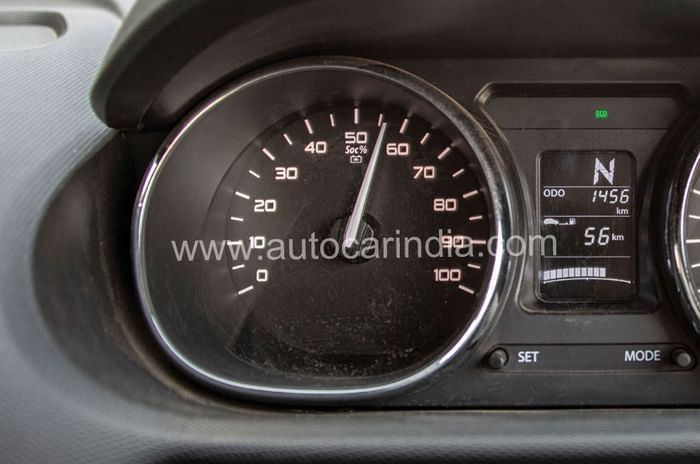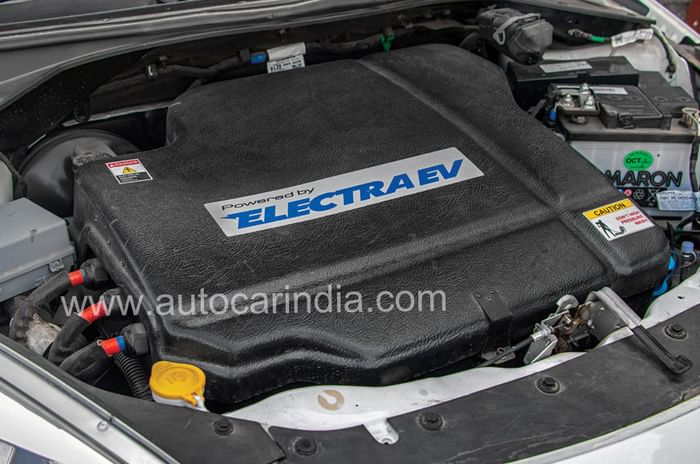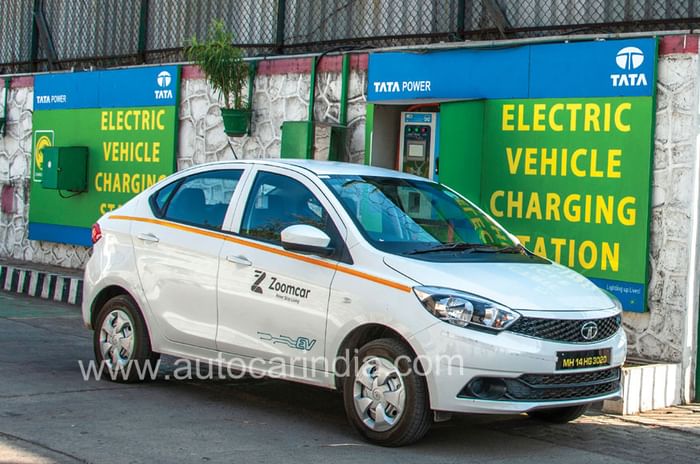What is it?
The Tigor EV made headlines in 2017 when Tata Motors won a tender to supply 10,000 units to the government’s Energy Efficiency Services Limited (EESL). More recently, the car has become available through car-hire services. However, there’s still no confirmed time frame on a mass-market launch, so you can’t actually buy a Tigor EV as yet. Question is, would you want to? To find out, we’ve hired one for the day from the self-drive service, Zoomcar.
Ignore the new badges and stickers and the EV could pass off as any other Tigor. The big modifications are hidden from view. There’s no combustion engine, of course, though the EV’s 3-Phase AC induction motor and ancillary elements occupy the same space in the engine bay. Also sitting prominently here is the AC charging socket. There’s DC fast-charging too (GB/T standard), the socket for which resides under the traditional fuel-filler cap. The underseat fuel tank has also made way for the 16.2kWh lithium-ion battery pack that extends to the boot floor. Resultantly, the spare wheel has been relegated to the luggage bay and this hurts practicality a wee bit.
Inside the cabin, you get the same neat dashboard, chunky seats, et al. The gear selector is from the Tigor AMT and the only point of difference, really, is on the instrument console where an analogue State of Charge (SOC) dial takes the place of the tachometer.

What’s it like to drive?
Twisting the familiar Tata key has the car come to life. Except, in the Tigor EV, there are no vibrations or accompanying engine noise on ‘ignition’. Instead, you rely on the EV version’s MID to tell you when it’s all systems go. The other reading of interest is range. With the SOC at 100 percent, the onboard computer is displaying a range of 98km. I deem it sufficient for the day’s driving but curiously the indicated figure is significantly lower than the Tigor EV’s ARAI-certified range of 142km.
The first impression of the Tigor EV on the move is fairly positive. The lack of noise from the engine bay is welcome and the powertrain also comes across as more refined than the Mahindra e2O’s. In the slow crawl through Mumbai’s suburb of Andheri East, the Tata glides along well, throttle responses are fine and the feeling is of being in a smooth automatic transmission-equipped conventional car. Even when the road opens up, the Tigor EV keeps up with the flow of traffic. There’s nothing alarming in the drop in range either. So far, so good.

It’s when we turn on to the faster confines of the Eastern Expressway that the Tigor EV feels out of its comfort zone and the lack of power becomes all too apparent. The Tigor EV’s motor puts out 30kW, which equates to just 40.7hp. This is insufficient for what is a family car, even though the Tigor EV is no heavyweight, tipping the scales at 1,126kg or about the same as a diesel Tigor. Shifting the EV’s gear lever to Sport makes the car feel livelier, but this is no Tesla on the cheap. It’s okay to about 50kph but the build-up of speed fizzles out thereafter, and it’s a long wait to see the speedo needle reach 80kph – the Zoomcar version’s governed top speed. We managed a 0-80kph time of 18.84sec, which is unremarkable by any measure.
The acceleration test runs also take their toll on the EV’s range. While this is understandable and cannot be held against the car, the drastic drop in the distance-to-empty number acquaints us with dreaded range anxiety. It’s like living life with a petrol car that's got a 10-litre fuel tank. To add to the drama, our car doesn’t have the wall charger apparatus, which is something I regret not checking beforehand. Our options are to drive down to one of Tata Power’s 33 EV charging points in and around Mumbai. I will not lie, it’s a tense drive to the one at Vikhroli, 17km from office. I go easy on the throttle and even coast down flyovers as much as reasonably possible to maximise regenerative braking, and thankfully we make it there with enough range.
Plugging into the 15kW DC fast charger is a straightforward exercise. The charging gun (and piping) is relatively heavy, so you’ll need both hands to lock it into place but that’s all there is to it. In the 36 minutes the car is plugged in, the SOC goes up by 36 percent, or enough to add 35km to range. With fast charging, the Tigor’s battery pack is rated to juice up to 80 percent in 90min. A standard 15A 220V wall charger gives a full charge in 6 hours.

Should you buy one?
And that’s a snippet of life with the Tigor EV. It’s a car with its heart in the right place, but the fact is, when it comes to performance and range, it feels more a promising first step than a viable alternative to a conventional combustion-engined car. And then there’s the not-so-small matter of price. The Tigor EV was billed to the EESL at around Rs 11.5 lakh per piece, and with FAME II (the second phase of the Faster Adoption and Manufacture of Electric Vehicles scheme) subsidies only available to commercial buyers, the final price for private buyers wouldn’t be much different. That’s simply way too much money for a car that has its compromises and just can’t match the flexibility of a petrol or (whisper it) a diesel.
Tata is in no hurry to launch the Tigor EV to the public at large and, as things stand, I don’t expect to see the public at large lining up to buy one either.
Zoomcar and ZAP Subscribe
We borrowed the Tata Tigor EV from pan-India self-drive car rental service, Zoomcar. If interested, you too can rent out the Tigor EV or one from a whole range of cars. Keen to use a car for an extended period but don’t want the financial burden of buying one? Zoomcar’s ZAP subscription service could be the solution for you. ZAP lets you ‘subscribe’ to a car of your choice for a period of 6, 12, 24 or 36 months, all for a single monthly fee. Costs of insurance, service and maintenance are included in the monthly fee. What’s more, you also have the option to offset the monthly fee by enlisting to rent your car out on Zoomcar’s app, when you are not using it. ZAP could just change the way we look at car ownership.
Want to try ZAP for yourself? Use code ‘ZCAUTOCAR’ and get a Rs 10,000* cashback on your first month subscription fee. Zoomcar users too can apply the code ‘ZC04AUTOCAR’ to get 20 percent off* (up to Rs 1500) on their ride.
*T&C apply - The offer is valid for a minimum booking of 36 hours.
| Tata Tigor EV specifications | |
|---|---|
| Kerb Weight | 1126kg |
| Motor Type | 72V, 3-phase AC induction |
| Power | 30kW at 4500rpm |
| Torque | 105Nm at 2500rpm |
| Battery type | Lithium-ion |
| Battery capacity | 16.2kWh |
| Range | 142km (ARAI certified) |
| Charging time | 6hr to full (15A, 220V AC) / 90min to 80% (15kW) [Not to Autocar test standards] |
| Accleration from rest (Claimed) | |
| 0-20kph | 2.56 sec |
| 0-40kph | 5.34 sec |
| 0-60kph | 9.42 sec |
| 0-80kph | 18.84 sec |









































